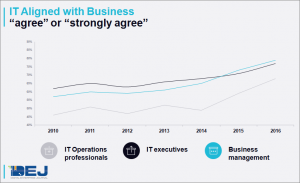For close to a decade, IT-business alignment was one of the key goals of IT and business leaders and one of the key messages of technology vendors. The problem was that very few organizations were able to fully achieve this goal. CIOs were complaining that they spent an increased amount of time on business related tasks, but had very little impact on business strategy and the role that technology plays in their organizations. On the other side, business leaders were getting frustrated about the lack of visibility into the business value that IT provides and the fact that, on average, 72% of IT budgets were spent on “keeping the lights on” – maintaining and managing existing services and infrastructure.
Organizational structures and strategy creation processes were not making addressing this challenge any easier as, for many enterprises, IT and business were “skating in different lanes” by default. Several management concepts were introduced to try to bridge this gap, but they fell short for the majority of organizations. Business Service Management (BSM) was a concept that, in theory, showed a lot of promise but was diluted when vendors’ messaging started turning it into something that was never meant to be – a technology class. With time, the term faded out, as its meaning shifted from an innovative management approach to a different spin on IT Service Management (ITSM).
However, over the last two years the data from our IT Monitoring surveys started showing significant changes in this area.
The question then becomes: what has been driving this change? The answer is: digital transformation and advanced analytics.
Digital Enterprise Journal’s (DEJ) IT Performance Monitoring research showed:
- 44% of organizations are looking to find a way to monetize their IT data
- 41% are using, or looking to use, IT Operations Analytics (ITOA) solutions outside of IT
- 46% reported that extracting network data for business use is one of their key goals for managing network data
- Advanced analytics are the #1 growth area for IT performance monitoring technologies
Additionally, DEJ’s Digital Transformation research showed that:
- 61% of organizations are looking to use technology as a source of competitive advantage
- 57% are looking to make IT more strategic
- 58% reported that, in order to become a digital business, their process for evaluating technologies will have to change and become more business centric
- Data layer is reported to be the #1 technology enabler of Digital Transformation (followed by Integration technologies)
The overarching theme of all of these trends are efforts to get business insight from IT data; advances in data collection and analysis capabilities of IT monitoring solutions are making it possible. Technology vendors are introducing solutions that can leverage data from a variety of sources, such as network, application transactions, user experience, machine logs and infrastructure elements, to provide information that benefit a variety of business roles. Furthermore, not only that this information is relevant for business decision makers, but it also provides them with unique insights that more traditional business reporting solutions would not be able to capture.
The mantra of “aligning IT with business” has multiple dimensions and goes well beyond technology capabilities to include areas such as strategy, culture, product development, process management, etc. However, having the ability to extract business insights from IT data is a very important step towards IT and business having a common view of the role that IT can play in digital economy.
DEJ’s research shows that 39% of organizations are adopting variations of the RGT (Run, Grow, Transform) for budgeting technology purchases. Traditionally, IT management solutions have been perceived as technologies whose purchases should be funded from the “Run” category. However, IT solutions that can provide a business insight are playing an important role in enabling growth and transformation, which puts them in a fairly unique position in a digital economy by allowing them to tap into resources from each of the three “buckets”.
So what does business insight really mean? Many IT monitoring vendors recognized that the terms “Business Intelligence (BI) for IT” and “Business-centric IT monitoring” resonate with their target buyers and are increasingly using it in their messaging. However, even though their solutions provide some visibility into the impact of IT performance on business services, they are rarely used or purchased by business users.
Digital Enterprise Journal identified 20 technology vendors that are providing innovative solutions for extracting business context from IT monitoring data and enabling multiple non-IT job roles to make better informed decisions. It should be noted that the primary purpose of the majority of these solutions is still IT performance monitoring, but their ability to provide business insights make them more valuable for end-user organizations, especially those that are looking to become digital businesses.


